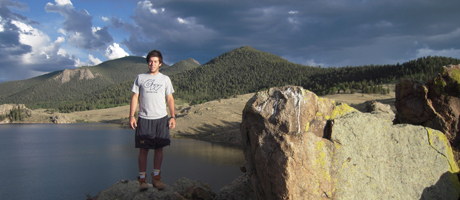By Jennifer Eder
Teaching Peruvian children about HIV and AIDS. Working alongside farmers in El Salvador to implement better agricultural techniques. And training teachers, youth and government officials in Namibia on computers.
These are just some of the things George Washington University grads will be doing this fall when they join the Peace Corps.
“I’m moving to Africa, and I’m 22,” says Julie Hyman, B.A. ’10, who will be serving as a communications technology volunteer in Namibia, a country in southern Africa. “I’m really excited to learn a lot about myself and help other people at the same time.”
The Peace Corps has traditionally been one of the biggest employers of GW grads. In fact, GW came in first last year among medium-sized universities producing corps volunteers with 53 undergraduate alumni serving overseas. Statistics for this year have not yet been released.
Next year, the Peace Corps will celebrate its 50th anniversary. In 1960, then-Senator John F. Kennedy challenged University of Michigan students to serve their country by living and working in developing countries. Since then, nearly 200,000 volunteers have served in 139 countries, working on issues ranging from health education, community development and environmental preservation.
Ms. Hyman, who majored in journalism and mass communications, is preparing to move to Namibia in August. In addition to shopping for appropriate clothing and a digital camera, Ms. Hyman is trying to talk to as many former or current volunteers as possible to find out what she should expect.
“Of course I’m nervous. I think it would be weird if I wasn’t partially terrified,” says Ms. Hyman, of Scotch Plains, N.J. “While I’m nervous about the bugs, getting sick and living in the desert, I’m most nervous about loneliness and how much I’m going to miss my family and friends.”
Ms. Hyman says she’s looking forward to teaching Namibians how to navigate the Internet and how to create a resume.
“I’m really hoping to touch someone’s life,” she says.
Brenda Tobin, B.A. ’10, has wanted to serve in the Peace Corps since she first heard about the organization in eighth grade. So when it came time to start thinking about what she wanted to do after graduating, she knew exactly where to turn.
Applying to the Peace Corps is no simple task. The application includes two essays and three letters of recommendation. If you make it past the first round, you are asked to come in for an interview. After that, you must receive medical, dental and legal clearance before getting an official invitation. And many volunteers don’t find out what country they’re going to until just a few months before their departure date.
Ms. Tobin, of Tucson, Ariz., found out in April that she would be leaving for Cambodia in July.
“I keep trying to pinch myself to make sure this is all real,” she says. “I’m excited to go over there and do what I’ve been talking about for years. The whole unknown is really exciting.”
For the first two months, Ms. Tobin will receive training in Phnom Penh along with all the other incoming Cambodia Peace Corps volunteers. She’ll live with a host family while receiving language, safety, cultural and technical training. Then after training, she’ll receive her official assignment and learn where she will be living and working in Cambodia for the next two years.
Max Greenblum, B.A. ’10, requested to serve somewhere in South or Central America so he could make use of the three years of Spanish he took at GW.
“I’m from Texas, and most of my family speaks Spanish so I wanted to become fluent,” says Mr. Greenblum, who majored in international affairs and political science.
Because Mr. Greenblum worked on several farms in Texas, he will be doing environmental and agricultural consulting as a Peace Corps volunteer in El Salvador.
“Soil erosion and deforestation are the biggest issues in El Salvador,” says Mr. Greenblum.
Laura Chambers, B.S. ’10, is hoping that serving two years in Peru as a community health promoter will give her more hands-on experience for a future career in public health.
“I really love learning about different cultures and history so I’m really excited to have such a long time to live in one place learning about the community and the people,” says Ms. Chambers, of Ann Arbor, Mich.
Brianna Casciello, B.A. ’10, will also be serving in Peru, where she’ll be developing education and awareness campaigns to promote nutrition, proper hygiene and disease prevention. She’ll train mothers on the importance of a balanced diet and how to breastfeed. And she’ll be helping to create community gardens.
“Peru is a beautiful country. I’m excited about waking up every morning and looking at a beautiful beach, mountain or forest,” says Ms. Casciello, who majored in international affairs and minored in Spanish language and literature. “That will be very different from waking up in D.C. and looking at a building and cement.”
While Ms. Casciello will be doing service work for the next two years, she doesn’t plan on helping people. Instead, she wants to empower them.
“I am looking forward to helping others realize their own potential. The idea isn’t to create dependence. It’s to create independence,” says Ms. Casciello, of Boston. “A lot of people, when they think of the Peace Corps, they assume that the volunteers are bettering the life of the recipients. But I like to look at it as give and take because I’m going to be learning too.”


